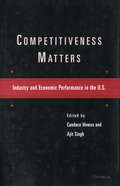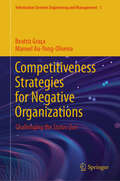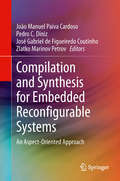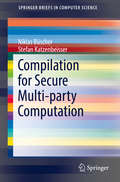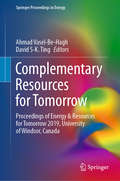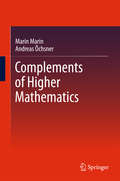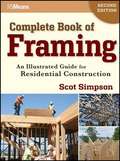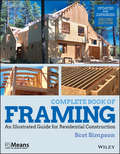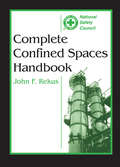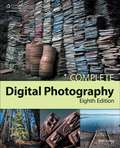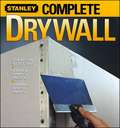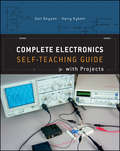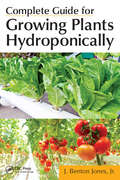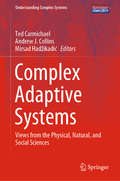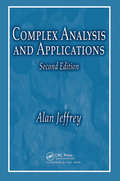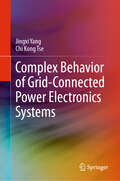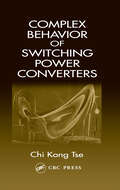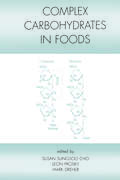- Table View
- List View
Competitiveness Matters: Industry and Economic Performance in the U.S.
by Candace Howes Ajit SinghThis book argues, against the current view, that competitiveness--that is, the competitiveness of the manufacturing sector--matters to the long-term health of the U. S. economy and particularly to its long-term capacity to raise the standard of living of its citizens. The book challenges the arguments popularized most recently by Paul Krugman that competitiveness is a dangerous obsession that distracts us from the question most central to solving the problem of stagnant real income growth, namely, what causes productivity growth, especially in the service sector. The central argument is that, if the U. S. economy is to achieve full employment with rising real wages, it is necessary to enhance the competitiveness of its tradable goods sector. The book shows that current account deficits cannot be explained by macroeconomic mismanagement but are rather the consequence of an uncompetitive manufacturing sector. It finds that the long-term health of the manufacturing sector requires not only across-the-board policies to remedy problems of low or inefficient investment, but also sectoral policies to address problems that are strategic to resolving the balance of payments problems. Lessons are drawn from the experience of some European and Asian countries. This book will be of interest to economists, political scientists, and business researchers concerned with the place of the manufacturing sector in overall health of the U. S. economy, with issues of industrial policy and industrial restructuring, and with the conditions for rising standards of living. Candace Howes is Associate Professor, Barbara Hogate Ferrin Chair, Connecticut College. Ajit Singh is Professor of Economics, Queens College, Cambridge.
Competitiveness Strategies for Negative Organizations: Challenging the Status Quo (Information Systems Engineering and Management #1)
by Beatriz Graça Manuel Au-Yong-OliveiraThe book aims to describe how a certain type of organisation may come into existence and may even become prevalent in society - what we call a negative organisation. This type of organization is one where the status quo prevails over what is best for the company, in strategic terms. Namely, certain employees who are actually very good may be forced to leave so as to not disturb the status quo and existing loyalties and ties which are actually prejudicial to the company, in the medium to long run. Change is very necessary and strategies need to change to accompany technological breakthroughs and other market developments. Wanting to maintain the same course so as not to “disrupt the waters” is often a bad strategy and the firm will suffer. Innovation must prevail over the maintenance of the status quo or, in other words, must prevail over the maintenance of the existing state of things and hierarchy. Our book discusses the topic as well as providing solutions for the situation of a firm becoming negative. Various levels of leadership in the organisation may contribute to a negative organisation and this too is discussed. We hope to have contributed in whatever small way to a more joyous, satisfactory and, above all, more productive and innovative workplace.
Compilation and Synthesis for Embedded Reconfigurable Systems: An Aspect-Oriented Approach
by José Gabriel de Figueiredo Coutinho Pedro C. Diniz João Manuel Cardoso Zlatko Marinov PetrovThis book provides techniques to tackle the design challenges raised by the increasing diversity and complexity of emerging, heterogeneous architectures for embedded systems. It describes an approach based on techniques from software engineering called aspect-oriented programming, which allow designers to control today's sophisticated design tool chains, while maintaining a single application source code. Readers are introduced to the basic concepts of an aspect-oriented, domain specific language that enables control of a wide range of compilation and synthesis tools in the partitioning and mapping of an application to a heterogeneous (and possibly multi-core) target architecture. Several examples are presented that illustrate the benefits of the approach developed for applications from avionics and digital signal processing. Using the aspect-oriented programming techniques presented in this book, developers can reuse extensive sections of their designs, while preserving the original application source-code, thus promoting developer productivity as well as architecture and performance portability. Describes an aspect-oriented approach for the compilation and synthesis of applications targeting heterogeneous embedded computing architectures. Includes examples using an integrated tool chain for compilation and synthesis. Provides validation and evaluation for targeted reconfigurable heterogeneous architectures. Enables design portability, given changing target devices· Allows developers to maintain a single application source code when targeting multiple architectures.
Compilation for Secure Multi-party Computation (SpringerBriefs in Computer Science)
by Stefan Katzenbeisser Niklas BüscherThis book presents a holistic view on compiler assisted practical secure multi-party computation (MPC) over Boolean circuits. It discusses that two or more parties jointly evaluate a function over their inputs in such a way that each party keeps its input unknown to the other parties in MPC. MPC provides a generic way to construct Privacy-Enhancing Technologies, which protect sensitive data during processing steps in untrusted environments. A major obstacle in the past was to generate MPC applications by hand. Recently, special compilers have been developed to build all kinds of applications. This book also explains in detail how efficient MPC applications can be created automatically from ANSI-C, thus, bridging the areas of cryptography, compilation and hardware synthesis. It also gives an insight into the requirements for creating efficient applications for MPC and is hence of interest to not only researchers in the area of MPC but also developers realizing practical applications with MPC. For a better understanding of the complete compile chain from ANSI-C to circuits, which is the 'machine code' of MPC, the authors first give the necessary background information on MPC protocols, Boolean logic, and logic synthesis. Then the authors describe the various compilation steps required to translate any code into an adequate circuit description. Afterwards, the authors introduce a variety of optimization techniques for two classes of MPC protocols, namely techniques that improve the runtime of applications in constant- and multi-round MPC protocols. The authors also illustrate how efficient parallelization of MPC protocols can be achieved using the assistance of compilers. It presents the effectiveness of the proposed techniques by giving a detailed evaluation on benchmarking applications. Most of the aforementioned techniques are implemented in our open source compiler that is accompanying this book and allows to study compilation for MPC in practice. Researchers who are interested in practical secure multi-party computation (MPC), and developers who are interested in realizing MPC applications in practice will find this book useful as a reference, as well as advanced-level students in computer science.
Complementary Resources for Tomorrow: Proceedings of Energy & Resources for Tomorrow 2019, University of Windsor, Canada (Springer Proceedings in Energy)
by David S-K. Ting Ahmad Vasel-Be-HaghThis book brings together the state-of-the-art in energy and resources research. It covers wind, solar, hydro and geothermal energy, as well as more conventional power generation technologies, such as internal combustion engines. Related areas of research such as the environmental sciences, carbon dioxide emissions, and energy storage are also addressed.
Complementary and Alternative Medicine IN THE UNITED STATES
by Institute of Medicine of the National AcademiesThe National Academies Press (NAP)--publisher for the National Academies--publishes more than 200 books a year offering the most authoritative views, definitive information, and groundbreaking recommendations on a wide range of topics in science, engineering, and health. Our books are unique in that they are authored by the nation's leading experts in every scientific field.
Complements of Higher Mathematics
by Andreas Öchsner Marin MarinThis book highlights the remarkable importance of special functions, operational calculus, and variational methods. A considerable portion of the book is dedicated to second-order partial differential equations, as they offer mathematical models of various phenomena in physics and engineering. The book provides students and researchers with essential help on key mathematical topics, which are applied to a range of practical problems. These topics were chosen because, after teaching university courses for many years, the authors have found them to be essential, especially in the contexts of technology, engineering and economics. Given the diversity topics included in the book, the presentation of each is limited to the basic notions and results of the respective mathematical domain. Chapter 1 is devoted to complex functions. Here, much emphasis is placed on the theory of holomorphic functions, which facilitate the understanding of the role that the theory of functions of a complex variable plays in mathematical physics, especially in the modeling of plane problems. In addition, the book demonstrates the importance of the theories of special functions, operational calculus, and variational calculus. In the last chapter, the authors discuss the basic elements of one of the most modern areas of mathematics, namely the theory of optimal control.
Complete Book of Framing
by Scot SimpsonThe updated easy-to-learn reference for rough carpentry and framing Complete Book of Framing, Second Edition is an updated, easy-to-learn guide to rough carpentry and framing written by an expert with more than thirty years of framing experience. This book guides the reader through the steps on framing floors, walls, roofs, door and window openings, and stairs. Hundreds of color photographs and illustrations help the reader understand the basics as well as advanced framing methods. This Second Edition is updated to match the framing techniques to the 2009 International Building Code, and introduces the concept of "green framing" regarding material use and handling. Deals with the new corrosive treating methods that began to be used in 2004 for pressure treated wood Covers the time and energy-saving benefits of positive placement nail guns, which have become the industry standard for fastening light gage hardware Includes a glue-laminated beam weight chart, along with a description of crane operations for setting these beams Starting with the basics, this book begins with types of lumber, nails, and what tools are needed, followed by detailed, fully illustrated steps for framing each building element--from planning and layout through specific nailing patterns. Framer-Friendly Tips throughout the book show how to get a task done right--and more easily.
Complete Book of Framing: An Illustrated Guide for Residential Construction (RSMeans)
by Scot SimpsonThe bestselling step-by-step framing guide—updated and expanded to meet 2018 codes and standards Complete Book of Framing, Second Edition—Updated and Expanded is a comprehensive guide to rough carpentry and framing, written by an expert with over forty years of framing experience. This book guides the reader through step-by-step framing instructions for floors, walls, roofs, door and window openings, and stairs. Hundreds of full-color illustrations and photos enable novice and professional framers to understand and master framing techniques. This Updated and Expanded Second Edition includes the framing techniques of the 2018 International Building Code (IBC), International Residential Code (IRC), and updated OSHA rules. It also includes new coverage of today's electric tools, wind and earthquake framing, medical and physiological factors of framing, and a revised safety chapter. Builders will find information on nailing patters, overall layout, engineered wood patterns, and green framing. In addition, the book offers readers tools and techniques for preparing for a job and managing a team. This Second Edition—Updated and Expanded: Includes hundreds of full-color illustrations depicting step-by-step framing techniques Offers guidance on today's electric tools and structural enhancements for natural disasters Features a revised chapter on safety to reflect the medical and physiological factors of framing Meets the framing techniques of the 2018 International Building Code (IBC), International Residential Code (IRC), and Occupational Safety and Health Administration (OSHA) standards Complete Book of Framing: An Illustrated Guide for Residential Construction, Second Edition—Updated and Expanded is an excellent resource for framers, carpenters, and contractors of all experience levels. Framer-friendly tips throughout the book show how to complete framing tasks efficiently and effectively.
Complete Confined Spaces Handbook
by John F. RekusThis book provides plant managers, supervisors, safety professionals, and industrial hygienists with recommended procedures and guidance for safe entry into confined spaces. It reviews selected case histories of confined space accidents, including multiple fatalities, and discusses how a confined space entry program could have prevented them. It outlines the requirements of the OSHA permit-entry confined space standard and provides detailed explanations of requirements for lockout/tagout, air sampling, ventilation, emergency planning, and employee training. The book is filled with more than 100 line drawings and more than 150 photographs.
Complete Digital Photography (Eighth Edition)
by Ben LongIn this updated eighth edition of COMPLETE DIGITAL PHOTOGRAPHY, popular photographer, writer, and teacher Ben Long guides you through the creative and challenging world of digital photography--from the ins and outs of shooting to the details of postproduction and printing. This book gives you everything you'll need to know in order to create great digital photos. Starting with an inside look at how a camera works, you'll progress through all the details of shooting, image editing, output, and workflow. With its step-by-step tutorials, you'll learn great tips and techniques that will help you understand and sharpen your process from start to finish. Among the many essential elements of digital photography covered are: using your camera's controls; understanding exposure; composing your pictures--the "artistry" of photography; crafting a postproduction workflow around Adobe Photoshop and Lightroom; and printing and output. No prior experience with digital photography is needed or assumed, and by the end of the book, you'll have the expertise to tackle complex photographic challenges on your own. Complete Digital Photography, Eighth Edition will help you master the equipment, the process, and the art of digital photography.
Complete Drywall
by Ken SideyComplete step-by-step instruction to build or repair walls and ceilings; Basic techniques to plan, select, cut, hang, tape, and sand drywall; Addresses drywall remodeling issues, and unusual situations; Professional drywall techniques for corners, curved walls, arched ceilings, and specialty finishes; Advice to help select tools and materials, including specialty drywall tools; Pre-start checklists, professional tips, and photographs give homeowners confidence to tackle advanced projects; Advanced projects, such as decorative construction and finishes.
Complete Electronics Self-Teaching Guide with Projects
by Earl Boysen Harry KybettAn all-in-one resource on everything electronics-related!For almost 30 years, this book has been a classic text for electronics enthusiasts. Now completely updated for today's technology, this latest version combines concepts, self-tests, and hands-on projects to offer you a completely repackaged and revised resource. This unique self-teaching guide features easy-to-understand explanations that are presented in a user-friendly format to help you learn the essentials you need to work with electronic circuits.All you need is a general understanding of electronics concepts such as Ohm's law and current flow, and an acquaintance with first-year algebra. The question-and-answer format, illustrative experiments, and self-tests at the end of each chapter make it easy for you to learn at your own speed.Boasts a companion website that includes more than twenty full-color, step-by-step projects Shares hands-on practice opportunities and conceptual background information to enhance your learning processTargets electronics enthusiasts who already have a basic knowledge of electronics but are interested in learning more about this fascinating topic on their own Features projects that work with the multimeter, breadboard, function generator, oscilloscope, bandpass filter, transistor amplifier, oscillator, rectifier, and moreYou're sure to get a charge out of the vast coverage included in Complete Electronics Self-Teaching Guide with Projects!
Complete Guide for Growing Plants Hydroponically
by Jr., J. JonesWith the continued implementation of new equipment and new concepts and methods, such as hydroponics and soilless practices, crop growth has improved and become more efficient. Focusing on the basic principles and practical growth requirements, the Complete Guide for Growing Plants Hydroponically offers valuable information for the commercial growe
Complete vehicle
by Michael TrzesniowskiIn this book, the reader learns the essential differences to the passenger car through the analysis divided according to assemblies. This gives him the tools to apply the detailed knowledge acquired to the design and development of competition vehicles. The course for a successful car is set in the concept phase. For this reason, it is given a lot of space and associated design-related areas such as the choice of materials, lightweight construction, design principles, reliability, etc. are discussed. When considering the vehicle as a whole, however, safety systems (rollover device, crash elements, restraining ropes), the cockpit (driver position, seat with restraint system, steering wheel, gearshift, pedal system), the frame or monocoque, the outer skin and aerodynamic devices (ventilation, aerodynamic drag, downforce) must not be omitted. The detailed, in-depth presentation makes the work just as suitable for the interested motorsport enthusiast as it is for the engineer with a practical interest in questions relating to the complete vehicle. The formula material is prepared in such a way that the book can also be used as a reference work. .
Completion Detection in Asynchronous Circuits: Toward Solution of Clock-Related Design Challenges
by Pallavi SrivastavaThis book is intended for designers with experience in traditional (clocked) circuit design, seeking information about asynchronous circuit design, in order to determine if it would be advantageous to adopt asynchronous methodologies in their next design project. The author introduces a generic approach for implementing a deterministic completion detection scheme for asynchronous bundled data circuits that incorporates a data-dependent computational process, taking advantage of the average-case delay. The author validates the architecture using a barrel shifter, as shifting is the basic operation required by all the processors. The generic architecture proposed in this book for a deterministic completion detection scheme for bundled data circuits will facilitate researchers in considering the asynchronous design style for developing digital circuits.
Complex Adaptive Systems: Views from the Physical, Natural, and Social Sciences (Understanding Complex Systems)
by Mirsad Hadžikadić Ted Carmichael Andrew J. CollinsThis book emerged out of international conferences organized as part of the AAAI Fall Symposia series, and the Swarmfest 2017 conference. It brings together researchers from diverse fields studying these complex systems using CAS and agent-based modeling tools and techniques. In the past, the knowledge gained in each domain has largely remained exclusive to that domain. By bringing together scholars who study these phenomena, the book takes knowledge from one domain to provide insight into others.Most interesting phenomena in natural and social systems include constant transitions and oscillations among their various phases – wars, companies, societies, markets, and humans rarely stay in a stable, predictable state for long. Randomness, power laws, and human behavior ensure that the future is both unknown and challenging. How do events unfold? When do they take hold? Why do some initial events cause an avalanche while others do not? What characterizes these events? What are the thresholds that differentiate a sea change from a non-event?Complex adaptive systems (CAS) have proven to be a powerful tool for exploring these and other related phenomena. The authors characterize a general CAS model as having a large number of self-similar agents that: 1) utilize one or more levels of feedback; 2) exhibit emergent properties and self-organization; and 3) produce non-linear dynamic behavior. Advances in modeling and computing technology have led not only to a deeper understanding of complex systems in many areas, but they have also raised the possibility that similar fundamental principles may be at work across these systems, even though the underlying principles may manifest themselves differently.
Complex Analysis and Applications
by Alan JeffreyComplex Analysis and Applications, Second Edition explains complex analysis for students of applied mathematics and engineering. Restructured and completely revised, this textbook first develops the theory of complex analysis, and then examines its geometrical interpretation and application to Dirichlet and Neumann boundary value problems.
Complex Analysis for Practical Engineering
by Kozo SatoMaximizing reader insights into the fundamentals of complex analysis, and providing complete instructions on how to construct and use mathematical tools to solve engineering problems in potential theory, this book covers complex analysis in the context of potential flow problems. The basic concepts and methodologies covered are easily extended to other problems of potential theory. Featuring case studies and problems that aid readers understanding of the key topics and of their application to practical engineering problems, this book is suitable as a guide for engineering practitioners. The complex analysis problems discussed in this book will prove useful in solving practical problems in a variety of engineering disciplines, including flow dynamics, electrostatics, heat conduction and gravity fields.
Complex Analysis with Applications to Flows and Fields (Mathematics and Physics for Science and Technology)
by Luis Manuel Braga da Costa CamposComplex Analysis with Applications to Flows and Fields presents the theory of functions of a complex variable, from the complex plane to the calculus of residues to power series to conformal mapping. The book explores numerous physical and engineering applications concerning potential flows, the gravity field, electro- and magnetostatics, steady he
Complex Behavior of Grid-Connected Power Electronics Systems
by Jingxi Yang Chi Kong TseThis book is a comprehensive resource on the latest research in the field of power electronics and systems. The authors provide a detailed analysis of the complex behavior and stability issues of grid-connected power converters, which are essential for integrating renewable energy sources into the power grid and improving the efficiency and flexibility of the grid's operation. The book offers a multidisciplinary approach that combines expertise in circuit modeling, control theory, nonlinear system analysis, and power electronics system design. It covers topics such as bifurcation, nonlinear oscillations, synchronization, and stability of grid-connected power converters. Additionally, it highlights the latest research in these areas, including the development of advanced control strategies that can adapt to changes in the grid's operating conditions and mitigate the effects of nonlinear behavior and other stability issues. Complex Behavior of Grid-Connected Power Electronics Systems is a must-read for anyone seeking to develop and implement efficient and reliable grid-connected power converters.
Complex Behavior of Switching Power Converters
by Chi Kong TsePower electronics is a discipline spawned by real-life applications in industrial, commercial, residential and aerospace environments. Much of its development evolves around some immediate need for solving specific power conversion problems. This comprehensive book focuses on the typical bifurcation scenarios and nonlinear behavior observed in swit
Complex Binary Number System: Algorithms and Circuits (SpringerBriefs in Electrical and Computer Engineering)
by Tariq JamilThis book is a compilation of the entire research work on the topic of Complex Binary Number System (CBNS) carried out by the author as the principal investigator and members of his research groups at various universities during the years 2000-2012. Pursuant to these efforts spanning several years, the realization of CBNS as a viable alternative to represent complex numbers in an "all-in-one" binary number format has become possible and efforts are underway to build computer hardware based on this unique number system. It is hoped that this work will be of interest to anyone involved in computer arithmetic and digital logic design and kindle renewed enthusiasm among the engineers working in the areas of digital signal and image processing for developing newer and efficient algorithms and techniques incorporating CBNS.
Complex Carbohydrates in Foods (Food Science and Technology)
by Leon Prosky Susan Sungsoo Cho Mark Dreher"Explores the effects of complex carbohydrates (starch, gums, and dietary fibers) on human physiological function and establishes an appropriate dietary intake level for inclusion on nutritional labels. Addresses current research, applications, and implementation issues."
Complex Conjugate Matrix Equations for Systems and Control (Communications and Control Engineering)
by Ying Zhang Ai-Guo WuThe book is the first book on complex matrix equations including the conjugate of unknown matrices. The study of these conjugate matrix equations is motivated by the investigations on stabilization and model reference tracking control for discrete-time antilinear systems, which are a particular kind of complex system with structure constraints. It proposes useful approaches to obtain iterative solutions or explicit solutions for several types of complex conjugate matrix equation. It observes that there are some significant differences between the real/complex matrix equations and the complex conjugate matrix equations. For example, the solvability of a real Sylvester matrix equation can be characterized by matrix similarity; however, the solvability of the con-Sylvester matrix equation in complex conjugate form is related to the concept of con-similarity. In addition, the new concept of conjugate product for complex polynomial matrices is also proposed in order to establish a unified approach for solving a type of complex matrix equation.
